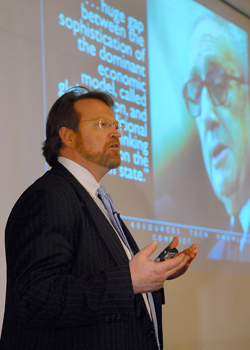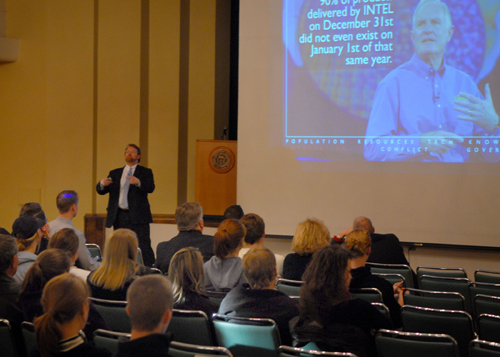
Warning: Challenges ahead
Seven important forces will alter our world by 2025, says Erik Peterson of the Center for Strategic and International Studies, a Washington, D.C., think tank. Each of these mega-trends will embody opportunities and danger in the years ahead. Together, they'll transform the way humans live and interact with each other. He calls them the Seven Revolutions.

By Rick Waters '95
Try and imagine: What will the world look like in the year 2025?
If you're like many Americans, it's hard to think about what will happen 17 days from now, much less 17 years.
Still, that was the question posed to an audience of about 500 in the Student Center Ballroom this week by Erik Peterson, senior vice president of the Washington, D.C.-based think tank Center for Strategic and International Studies (CSIS).
"While many of us are consumed with the urgent matters of the present," Peterson said, "we must find a balance between the immediate dilemmas that challenge us and long-term system failures."
Peterson called on the audience to embrace the words of French writer Antoine Jean-Baptiste Saint Exupery: "Your task is not to foresee the future, but rather to enable it."
 In 1962 when CSIS was founded, Peterson and the original members of the think tank couldn't conceive of the world in which we live in 2008: iPhones, unprecedented access to information, a global war on terrorism, corporations eclipsing countries as economic powers. In 1962 when CSIS was founded, Peterson and the original members of the think tank couldn't conceive of the world in which we live in 2008: iPhones, unprecedented access to information, a global war on terrorism, corporations eclipsing countries as economic powers.
"It was unthinkable to imagine Nelson Mandela becoming a world leader from apartheid-ridden South Africa, yet he has," Peterson said, with a montage of images flashing behind him on screen, from the Beatles to Tiananmen Square to the Challenger explosion to Osama bin Laden to the avian flu.
"The same is true for us," he continued. "Except in 2008, it is much more likely that we can anticipate what the world will be like."
The world, Peterson says, has set in motion uncheckable trends of poverty, infectious disease, conflict and technological might. Now, it's a matter of how we manage these mounting challenges.
"Einstein said, 'No problem can be solved by the same consciousness that created it.' Leaders of the world are going to have to raise the consciousness of everyone the planet."
Yet leaders are under greater strain than ever before, having less time to think beyond short-term priorities. Instant information shrinks planning timetables, and pressures from multiple stakeholders are eroding consensus building. In short, it's becoming increasingly difficult for leaders to act in the short term in ways that will yield long-term results.
Peterson's seven key drivers for change to expect are:
1) Population At the time of Julius Caesar, the world had roughly 150 million people on it. By Columbus' voyage to the new world, it was 500 million. Today, it's 6.6 billion, with the majority coming since World War II. That's a increase by a factor of 13. By 2025, global population will exceed 8 billion.
That means 77 million people are born every year. Or 146 every second. Or 2.4 births every second.
To know one's surprise, the highest growth rates will occur in the poorest countries, which are least equipped to support it.
Migration will be another key challenge. By 2025, some 1.35 billion – 15 percent – will be moving from their country of origin. Nearly 60 percent will live in cities, creating health, resource and governance problems.
At the same time, we're getting old – and rapidly. By 2025, some 2 billion will be 60 or older, 380 million will be over 80.
 2) Resource management and environmental stewardship Out to the year 2025, the most critical strategic resources in the world will not be oil. It will be clean water and food. The combined effects of population growth and income growth are expected to double global food consumption in the next 20 years. 2) Resource management and environmental stewardship Out to the year 2025, the most critical strategic resources in the world will not be oil. It will be clean water and food. The combined effects of population growth and income growth are expected to double global food consumption in the next 20 years.
Food production has increased around the globe, but the world is reaching a point of diminishing returns. Poor land management and overuse of fertilizers are causing land degradation, soil erosion and desertification.
Industrialization and food production is putting stress on the supply of clean water. These trends are leading to a period marked by water scarcity, toxic water quality and sanitation challenges. By 2025, United Nation estimates show 54 countries will be classified as facing water demand constraints.
The demand for oil and hydrocarbons will not be slowed. OPEC nations will account for half the world's oil production. Skyrocketing demand, primarily from Asia, will drive these trends.
Goldman Sachs estimates that the number of cars in China could rise from 12 million in 2004 to 500 million by 2050. In India, the number of cars could increase even faster, from 5 million to 600 million. Compare these numbers to the 200 million vehicles currently on the road in the United States — a vehicle fleet which consumes about 11 percent of the world?s current daily oil output.
3) Technological innovation and diffusion Over the next 17 years, computation, biotechnology, genomics and nanotechnology will likely drive more a technological transformation. Technology will test individuals, cultures and nations to adapt to a constellation of new opportunities and threats.
In June 2005, IBM?s two eServer Blue Gene Solution computers achieved computational capacities of 280 teraflops (280 trillion calculations per second) and 114 teraflops, respectively, making them the most powerful supercomputers in the world. In addition to achieving unimaginable new speeds, computers are becoming ubiquitous. Wireless laptops, personal e-mail and communication devices, media players, and on-board navigation systems demonstrate how technology has already made computational power and networked information constantly available.
The completion of the Human Genome Project, mapping the 30,000 genes and sequencing the three billion chemical base pairs that make up the human genome, marked an incredible achievement in the history of humankind. In the future, we can expect greater scientific advances in the areas of proteomics — the study of the role of and interaction between the body?s more than 300,000 proteins — as well as genetic and even germ-line therapy. With the advancement of new technologies and medicines, children born today could live into the 22nd century.
Scientists have already achieved significant successes in the micro-miniaturization of sensors, activators, and actuators. Micro-electromechanical machines (MEMs), smaller than dust mites and formed out of microscopic gears, chains, and computer chips, are already being deployed in medicine, agriculture,
supply chain management, materials science, manufacturing, and warfare. At TCU, we see our own engineering professor Ed Kolesar leading in this field. Ten to 15 years from now, that field may require two million nanotechnology workers as the industry moves from the current microscopic level down to the molecular and atomic level.
Unfortunately, each of these technological advancements also carries potential downsides. The combination of deep computing and pervasive computing through data mining could be used for serious violations of individual privacy. The unprecedented level of control over crops, livestock, and even human life itself has already prompted serious backlash. Future discoveries will challenge leaders to respond to new ethical complexities and public policy challenges.

4) Development and dissemination of knowledge The world is witnessing the growth of what former Federal Reserve Chairman, Alan Greenspan, has termed
the "weightless economy" an economy in which knowledge and technical capacity assume ever more significant positions relative to the "material" world. The best students and entrepreneurs of the developing world are no longer limited by geography and their home country?s development. As information technology continues to reach these workers, they will be able to compete more directly with those in the developed world.
In the wake of this competition, information will become increasingly perishable. Furthermore, as the information economy continues to mature, average workers will experience a half-dozen major career changes during the course of their professional lives. In a highly dynamic, knowledge-based economy, constant learning and retraining are not simply desirable; they are necessary to stay relevant. Education systems must adapt to prepare individuals to compete in the global arena. The growing prevalence of cyber-universities and distance-learning courses are an outgrowth of this anticipated need, both in the developed and developing world.
5) Economic Integration According to the U.N. Development Program, the accumulated wealth of the 225 richest individuals in the world is equal to the combined annual earnings of 2.7 billion of the world's poorest people.
Despite the rising international debate against continued economic liberalization, we believe that further global integration will continue out to the year 2025. The benefits of integration to both developed and developing countries are clear. The Euro area?s GDP now rivals that of the United States while the UN maintains that economic integration has allowed a number of developing countries to achieve in 30 years what it took industrialized nations up to100 years to accomplish. Consider, for example, that real per capita GDP in Asia more than doubled between 1980 and 2000. While there may be temporary setbacks along the path to deeper integration, the world has clearly benefited from liberal economic
reforms and continued momentum for greater integration appears to be likely in the long-term.
Brazil, Russia, India and China will increasingly define the world's new economic
center. According to a report from Goldman Sachs, if they can consolidate conditions conducive to structural growth, the total GDP of the "BRIC" economies by the year 2025 could equal half the aggregate level of the G-6 countries (United States, Japan, Germany, UK, France and Italy).
6) Nature and mode of conflict This new era of conflict can be characterized by asymmetric warfare in which dominant military powers are confronted by a wide range of adversaries—from non-state radical ideologies to transnational criminal
elements to rogue states—employing unconventional tactics in a war ambiguous in both place and time.
From suicide bombers to information warfare, the threat is multi-dimensional.
The attacks of September 11, 2001 introduced the possibility of asymmetrical super-violence, and they have been echoed time and again from London to Indonesia. In the future we can expect this trend to continue and at an ever-greater scale. Put another way, from now on, any terrorist group planning its own terrorist activity is going to use what was done on September 11 as the standard for success. These asymmetric foes will increasingly focus on the acquisition and
use of chemical, biological and nuclear weapons (known collectively as weapons of mass destruction.
7) Challenge of governance Increasingly, companies face the challenge of juggling a triple bottom line from shareholders, management, and the public at large in a new form of civic engagement known as corporate citizenship. Revenues of the Wal-Mart Corporation in 2004 totaled $263 billion, placing it between Austria and Indonesia as the 22nd largest economic entity in the world (when total revenue is compared with gross domestic product).
This success comes with new responsibilities. The 2004 Cone Corporate Citizenship Study shows that eight in 10 Americans say that corporate support of social causes wins their trust in a company — a 21 percent increase in this response since the first survey in 1997.
As globalization, trade and technology impact societies, non-governmental organizations (NGOs) have become increasingly influential in world affairs — filling gaps in the provision of social services, leveraging positions in political arenas, and connecting people, money, and ideas across the world. The United
Nations Human Development Report counted 37,000 registered international NGOs in 2000, and those numbers are expected to grow significantly in the decades to come.
More information: http://7revs.csis.org

Comment at tcumagazine@tcu.edu
|



